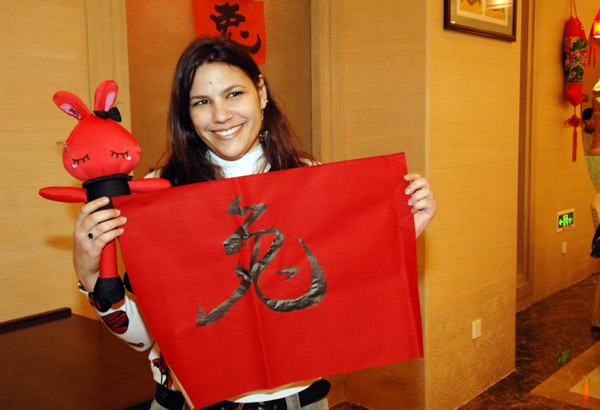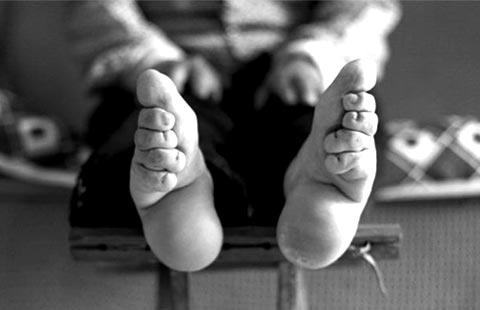China, Cuba to further advance ties
Updated: 2014-07-21 10:34
By Chen Weihua in Havana (China Daily Latin America)
|
||||||||
|
 A Cuban student, identified as Luo Xiao by her Chinese name, holds up her calligraphic work of Chinese character "rabbit" at Beijing Language and Culture University in this file photo taken on Feb 1, 2011. More than 60 international students from 20 countries and regions gathered on the eve of the Chinese New Year, which fell on Feb 2. The year 2011 was the Year of the Rabbit, according to Chinese Zodiac. Zhao Wanwei / Xinhua
|
With a long track record of deeply rooted friendship, many Chinese see Cuba as a country that is far geographically yet close at heart, Chen Weihua reports from Havana.
To many Chinese, Cuba is a country that is far geographically yet close at heart. The two countries established diplomatic relations in September 1960 to help each other's causes.
It also made Cuba the first Latin American country to set up diplomatic ties with the People's Republic of China.
The China-Cuba Friendship Primary School in Beijing, which got its name in 1964 and has a school song eulogizing the friendship between the two countries, stands as a testimony of the relationship.
Bilateral relations have developed steadily, reflecting the good feelings the people in the two countries have toward each other.
Just in East China's coastal metropolis of Shanghai, where the new BRICS bank will be headquartered, a statue of Jose Marti, a Cuban national hero, was unveiled in January this year in the downtown Yanfu Park to mark the 161st anniversary of his birth. Chinese students who studied in Cuba recited Marti's poem in both Chinese and Spanish, while Cuban musician sang songs with his poem as lyrics.
And in late June, Cuban young visual artist Asniel Herrera Gongalez, also known as "Chuli" displayed his work at the Latin American and Caribbean Cultural Center (LACC) in Beijing.
A Cuban delegation, of mostly officials from the University of Havana, went to Beijing last December to attend the 8th Confucius Institute Conference.
At the Confucius Institute (CI) at the university in the Cuban capital this April, eight contestants participated in the final of the fifth National University Competition, Chinese Bridge 2014, dazzling the audience with their Chinese-language skills and understanding of Chinese culture.
Hundreds of students at the University of Havana each year enroll in various courses at the CI.
In the beach resort town of Tarara, about 20 km east of Havana and not far from the summer villa where Che Guevara once lived, more than 1,000 Chinese students are studying on a five-year program in subjects that include Spanish, education, psychology and nursing.
The campus was established in 2007 under an agreement between the Chinese and Cuban governments to bring students from western China to the Caribbean island. It is the largest education exchange program between the two countries.
Many graduates left the school with fond memories of Cuban people, especially teachers and other staff members who treat them like families. Some return to China to pursue careers, while others pursue further studies in graduate schools in China and Spanish-speaking countries.
The huge column monument in Havana commemorating Chinese Cubans fighting for Cuba's independence from Spain in the late 19th century made Chinese visitors feel proud. The Spanish inscription on it says that no Chinese Cuban is a deserter and no Chinese Cuban is a traitor.
The monument also reminds many of the some 150,000 Chinese immigrants brought to Cuba to work mostly in agriculture in the mid and late 19th century, many as coolies. Some historic buildings in Havana's Chinatown, once the largest in Latin America, also seem to tell the stories of the old days.
Watching the mushrooming of private vendors, cab drivers and the launch of an economic development zone, many Chinese see today's Cuba as reflecting their own country of the early 1980s when it embarked on ambitious economic reform and an opening up program, unleashing decades of rapid economic growth and making China second-largest economy in the world today.
The foreign direct investment law approved by the Cuban legislature in late March has also drawn much attention from Chinese businesses, which are increasingly going global.
To many of them, Cuba holds great potential. And the place that has been in the spotlight is the Mariel special development zone, which promises tax breaks for foreign investors. The zone covers 465 square kilometers about 45 km west of Havana and will center on a new container terminal under construction in Mariel Bay. China's first special economic zone, Shenzhen, established in a small fishing village just four decades ago, has already become one of the most modern cities in the country.
Cuban Ambassador to China Alberto Blanco Silva recently told Chinese media that Cuba welcomes Chinese companies' investment and cooperation for the Mariel development zone, in areas such as biotechnology, pharmaceuticals, renewable energy, food processing, packaging, telecommunications and information technology.
BYD Auto, a Chinese automobile manufacturer based in Shenzhen, has expressed interest in building an assembly plant in Mariel. BYD already has a foothold in other parts of Latin America.
Ningbo Zhaoke, an import and export company from east China's Zhejiang province, has also expressed interest to increase its presence in Cuba, Chen Xilin, a representative from the company, told Cuban media while participating in the first Cuban Industry International Convention and Exhibit (CUBAINDUSTRIA 2014) last month.
In Santiago, another major Cuban port city, the China Communications Construction Co Ltd signed an agreement early this year with the local Port Industry Group, known as ASPORT, to build a multi-purpose terminal to boost capacity. It will include a 231-meter pier, berths, warehouses, railway access, weighing system, administration and other facilities that will greatly improve the port's efficiency.
Already, some 500 buses made by Yutong, based in Zhenzhou of central China's Henan province, are running on Havana's streets, and more are expected t in the coming years.
During Chinese President Xi Jinping's visit to Cuba, meetings have been set on July 21 for business and government representatives from China to better understand the investment environment in the Mariel development zone.
The bilateral trade, which is still relatively low, is likely to surge. China is now Cuba's second-largest trade partner while Cuba is China's largest trade partner in the Caribbean.
According to the Chinese Customs, two-way trade stood at $1.879 in 2013. China's exports of $1.374 billion to Cuba last year mainly included refrigerators, buses, pickup trucks, power generators and other machinery. Cuba's exports of $505 million to China were mainly nickel, sugar and other agricultural products.
The two governments have signed dozens of bilateral agreements to boost exchange and cooperation in economic, trade, education, science and technology and sports.
In April, the China-Cuba Moringa Science & Technology Cooperation Center was launched at southwest China's Yunnan Tropical Crop Research Institute. A similar one is expected to be set up in Cuba later.
Meanwhile, more Chinese tourists are visiting Cuba. Their number totaled 22,200 in 2013, up 18 percent from the previous year.
Bilateral political relations have been strong. As a permanent member of the United Nations Security Council, China has been a strong advocate calling for the US to end its more than 50-year-old economic sanctions. Last fall's vote at the UN General Assembly saw 188 countries in favor and only two countries, the US and Israel, against it.
High-level exchanges have been strong. Xi already met both Cuban leaders Fidel Castro and President Raul Castro, in a friendly environment in 2011 when he visited Cuba as China's vice-president.
Before starting this new trip, Xi has described the bilateral relationship between China and Cuba as an example of unity and cooperation between developing countries.
Chinese Foreign Minister Wang Yi also visited Cuba in April to prepare for the trip, when he told President Raul Castro that China and Cuba are good friends, good comrades and good brothers.
Over the years, many top Chinese leaders, including former presidents Jiang Zemin and Hu Jintao, have visited Cuba, while Cuban leaders, including Fidel Castro and Raul Castro, have made multiple trips to China.
Yuan Dongzhen, a researcher at the Institute of Latin American Studies at the Chinese Academy of Social Sciences, agreed that China and Cuba hold great potential in further developing their relationship.
He said Cuban leaders have put special emphasis on studying China's experience in its reform and opening up and believe it's useful for Cuba.
But Yuan also believes the different national situations also means that it's not to simply copy what China has done.

 Brazil launches China desk to handle economic ties with China
Brazil launches China desk to handle economic ties with China
 NY Wheel reels in Chinese EB-5 investors
NY Wheel reels in Chinese EB-5 investors
 The Penguins of Madagascar to enter China
The Penguins of Madagascar to enter China
 Panda cub Bao Bao turns one
Panda cub Bao Bao turns one
 HK kid's symphony returns to NY
HK kid's symphony returns to NY
 China, US reach agreement
China, US reach agreement
 40 bodies from jet returned to Dutch soil
40 bodies from jet returned to Dutch soil
 Dance troupe's fusion performance wins over judges
Dance troupe's fusion performance wins over judges
Most Viewed
Editor's Picks

|

|

|

|

|

|
Today's Top News
Manufacturing hits an 18-month high
Transformers producers hit with breach of contract suit
US chipmaker to be deemed monopoly
Chinese still seek Beckel termination
One dead in shooting in Philadelphia
France: Air Algerie plane 'probably' crashed
TransAsia crash while landing in Taiwan
China, UC-Davis set up food safety center
US Weekly

|

|






